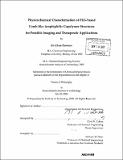Physicochemical characterization of PEG-based comb-like amphiphilic copolymer structures for possible imaging and therapeutic applications
Author(s)
Dawson, Jin Zhou
DownloadFull printable version (43.71Mb)
Alternative title
Physicochemical characterization of polyethylene glycol-based comb-like amphiphilic copolymer structures for possible imaging and therapeutic applications
Other Contributors
Massachusetts Institute of Technology. Dept. of Chemical Engineering.
Advisor
Clark K. Colton.
Terms of use
Metadata
Show full item recordAbstract
Comb-like copolymer structures, also known as graft/comb copolymers, have obtained a significant amount of attention in biomedical and industrial applications because of their unique compositional flexibility, which can lead to versatile structures in bulk, melt, and solution states. With biomedical applications (cancer diagnosis and treatment) as the context, this thesis is aimed at characterizing a series of polyethylene glycol (PEG) -based highly adaptable amphiphilic comb copolymer structures in their solution state that can serve as carriers and potentially contrast enhancement agent in magnetic resonance imaging (MRI). To successfully develop and implement such a delivery/contrast agent system, an adequate understanding is needed concerning their physicochemical properties: stability, size, morphology, local structural information, and magnetic resonance characteristics. The stability of these copolymer structures was characterized by their critical micelle concentration (the lower this concentration, the higher the stability), which was determined by total intensity light scattering and surface tension measurement. The size, morphology, and detailed structural information were studied by a combination of techniques, i.e., dynamic light scattering, transmission electron microscopy, cryogenic transmission electron microscopy, and small angle neutron scattering. Furthermore, solutions of polymer structure containing perfluorocarbon blocks were characterized by 19F magnetic resonance spectroscopy to evaluate their application for MRI contrast enhancement. Perfluorocarbon-containing comb copolymers (i.e., PEG-PFC) in solution had a low CMC of about 2 [mu]m. They were found to form two populations of particles - small micelles and large secondary aggregates. Hydrodynamic radius of micelles did not change with polymer concentration, PEG length, sample preparation method, or time after sample preparation. Large secondary aggregates were most likely compound micelles. Sample preparation method, polymer molecular weight, and time after sample preparation could change the proportion of micelles vs. aggregates. (cont.) Due to its "perfluoroalkyl-philic" property, PEG-PFC copolymer was able to encapsulate a perfluorocarbon compound, 1H, 1H, 2H, 2H-Perfluoro-l-decanol. 19F-NMR spectroscopy of PEG-PFC polymer solution showed significant spectral line broadening and consequent signal to noise (SNR) decrease due to micelle formation. Furthermore, hydrocarboncontaining comb copolymers (i.e., PEG-HyC) in PBS had a CMC of about 12 [mu]M. The micelles formed by PEG-HyC copolymer had an Rh of about 4-5 nm that did not change with polymer concentration. Because of the formation of nano-size micelles, both PEG-PFC and PEG-HyC copolymers are good candidates to be developed as delivery vehicles for imaging and therapeutic agents. Their low CMC is an indication of their potential ability to maintain micelle integrity in situations of massive dilution. PEG-PFC copolymers could also be used to encapsulate insoluble fluorinated drugs. Though micelle formation of PEG-PFC copolymer caused significant 19F-NMR spectral line broadening and consequent SNR reduction, the copolymer can be modified to act as smart 19F-MRI probes for cancer diagnosis.
Description
Thesis (Ph. D.)--Massachusetts Institute of Technology, Dept. of Chemical Engineering, 2008. Includes bibliographical references (p. 225-267).
Date issued
2008Department
Massachusetts Institute of Technology. Department of Chemical EngineeringPublisher
Massachusetts Institute of Technology
Keywords
Chemical Engineering.